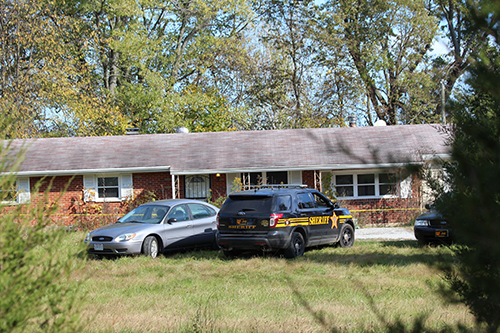Friends and family of Joseph Graley III of Bethel Township told a Miami County jury about their growing concerns for his safety in October 2014 during the murder trial of Frank Bowen, 26, of rural Tipp City.
The jury was scheduled to begin deliberations Tuesday, Jan. 19, in county Common Pleas Court in the retrial of Bowen in the death of Graley whose remains were found Oct. 23, 2014, under a pile of sticks and debris behind his Scarff Road home. A coroner’s investigator said he died of blunt force trauma to the head and neck.
A jury last summer was unable to reach verdicts on the charges against Bowen of murder, tamping with evidence and gross abuse of a corpse. They found Bowen guilty of felony safecracking involving a safe in Graley’s home.
The second jury was seated Jan. 12 and heard testimony from prosecution witnesses Jan. 12-15 before leaving for the holiday weekend. The defense did not present any witnesses in the trial being held before Judge Christopher Gee. The jury was to hear closing arguments before beginning its deliberations Tuesday.
In opening statements, Janna Parker, assistant county prosecutor, said Bowen and Graley were friends when Graley opened his home to him a few days before he disappeared Oct. 8, 2014.
Bowen was living with Graley because Bowen was broke, unemployed, homeless and had a young child to support, Parker said.
“Joe opened up his home to him. Within a matter of days, he was dead,” she said.
Friends and family repeatedly asked Bowen about Graley’s whereabouts in the days between Oct. 8 and Oct. 23, 2014, when his remains were found. They gave differing stories, she said.
“In the two weeks Joe was missing … the only one who didn’t seem to show any concern” was Bowen, Parker said. She claimed Bowen stayed in Graley’s house, used his car, played his video games and sold Graley’s drugs.
Defense lawyer Steve Layman said police procedure in the case would be questioned.
He said prosecutors had evidence potentially linking Bowen to a crime but couldn’t make critical connections that would move him from a suspect to a murderer.
Layman asked the jury to look for evidence on when and where the murder took place and for explanations on how Bowen’s DNA got on a sledgehammer.
“You have to allow your common sense to look at the big picture,” Layman said. “When you consider the unknowns with the knowns, you will have considerable doubt.”
The opening statements are not evidence in the case.
During testimony, sheriff’s Deputy Ethan Ennist and others described response to a call to the department Oct. 22, 2014, about Graley being a missing person. While checking the property late that day, deputies found a body pillow and towel, both believed to have blood on them, in an area behind Graley’s house.
The same evening Bowen was arrested on a warrant unrelated to the investigation and jailed.
The investigation continued into the next day when a bloodhound helping search the Graley property located his remains near a wellhead and tree line behind his house.
Friends and family told investigators they grew increasingly concerned when they did not see or hear from Graley for a couple of weeks. Several said they were told by Bowen that the last he saw Graley was when he told him he was accompanying his mother to a funeral of an uncle in Michigan. Others said Bowen said Graley was in drug rehab.
The mother, Terri Coburn of St. Paris, said there was no family funeral in Michigan and she did not place her son in rehab. The last she saw her son was a couple of days before he disappeared when she dropped off clothes for him to wear to a job interview, Coburn said.
Long-time Graley friend Billie Eason of West Milton told the jury she talked with Graley frequently. She visited his house several times inquiring about his whereabouts and was told Graley was with his mother. When she contacted Graley’s mother a couple of days before the remains were found, Eason said she knew something was wrong.
Dr. Lee Lehman of the Montgomery County Coroner’s Office testified a time of death for Graley could not be determined, but said the remains indicated he had been deceased for an extended time. Lehman said Graley’s skull was fractured and almost every bone in his face shattered.
Graley suffered multiple blows to the head, he said.
A sledgehammer with Graley’s blood was found by investigators in the wooded area behind the Graley home. Lehman said injuries Graley sustained were consistent to the size of the sledgehammer.
Defense lawyers asked Lehman about toxicology findings. Lehman said Graley had various drugs in his system but none to a level that would contribute to death.
Hallie Garofolo, a forensic scientist in the Bureau of Criminal Investigation DNA unit, testified DNA of both Graley and Bowen was found on the sledgehammer handle.
Defense lawyers questioned her why DNA testing wasn’t done on the twigs and other debris found covering Graley’s remains. Garofolo said those items would have been exposed to the elements for possibly a couple of weeks, leaving little chance any touch DNA would be found on them.
Sheriff’s Maj. Steve Lord, who was the lead investigator in the case, described the investigation and the handling of the Graley property after he had been reported missing.
Defense lawyers repeatedly questioned Lord about not making the property a crime scene after the body pillow and towel were found behind the house Oct. 22. At that point the case involved a missing person and the property was handled as it would have been in past cases, he said.
Lord also described his interview with Bowen the morning before Graley’s remains were found.
Bowen told him that he thought Graley was dead, he said. “He said, ‘I think in my heart of hearts something has happened to Joe,’” Lord testified.


